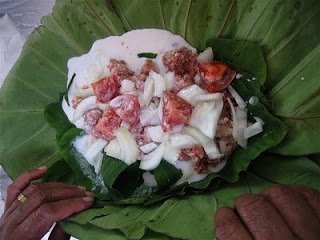Make your own Tongan lūpulu at home
You don’t need to live on a tropical island or cook in an underground oven to make lūpulu, one of Tonga’s most favorite dishes for your own feast:
As Alamoti Taumoepeau, manager of the Tonga Village at the Polynesian Cultural Center, explained in another article on Tongan feasting, lūpulu is a delicious combination of coconut cream; corned beef (the pulu part of the name, from the English word “bull”), seasoned to taste with onions, salt, maybe some tomatoes and other condiments; and soft, young taro leaves (the lū part of the name) laid out in an aluminum pan and baked together.
However, in preparing this dish at home you might need to make a few substitutions. For example, coconut cream is now widely available in cans (but check closely, because some brands half-dilute the cream with water); a 12-oz can of ground corned beef should do it (islanders prefer theirs from New Zealand; but a brisket also works); and collard greens or spinach leaves can take the place of the taro tops. Even Tongans substitute the meat sometimes, using chicken (which would then be called lūmoa), lamb (lūsipi) or fish (lūika).
President “Chef Prez” Galea’i, a former PCC Food Services pantry lead and head chef at Pounders Restaurant, showd you how to make your own lūpulu in his recent YouTube video at: https://www.youtube.com/watch?v=x-02NKmDCdk
Story by Mike Foley

Mike Foley, who has worked off-and-on
at the Polynesian Cultural Center since
1968, has been a full-time freelance
writer and digital media specialist since
2002, and had a long career in marketing
communications and PR before that. He
learned to speak fluent Samoan as a
Mormon missionary before moving to Laie
in 1967 — still does, and he has traveled
extensively over the years throughout
Polynesia and other Pacific islands. Foley
is mostly retired now, but continues to
contribute to various PCC and other media.


Can I cook 2 large pans (one on top rack and one on a bottom rack) at the same time without burning the bottom or top tray?
This would be based more on your oven. Typically, this is something you may be concerned about. One idea would be to trade which pan is on top and bottom once or twice during the cooking session. But take care! Transferring pans with hot contents can be tricky. Consider using deeper pans that won’t allow the contents to splash over the sides as easily. Another possibility is to place your pans in larger cookie sheets that have small, but significant sides (not flat cookie sheets) to catch any spillage.